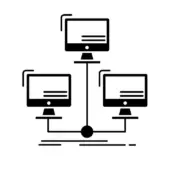In a digital landscape defined by its hypercompetitive nature, user experience (UX) can make or break a product or company’s ability to connect with consumers. An intelligent, properly focused UX strategy can, therefore, deliver major competitive advantages.
A complete approach to UX strategy considers both the business and human value propositions that flow from well-planned, user-centric designs. From a business standpoint, these include whopping returns of up to $100 for every $1 invested in UX, along with conversion rate increases as high as 200%. From a human user–focused standpoint, a strong user experience can advance accessibility, inclusivity, and desirability. Each concept has intangible but powerful impacts on consumer perception of a product or website.
Understanding User-Centric Products
UX strategies primarily strive to develop user-centric products. Marketing and UX experts define user-centric products as products that prioritize their users’ unique and specific needs. They preemptively anticipate and address challenges and pain points—while enhancing functionality by optimizing features that help users meet the needs that initially guided them to interact with the product.

Products that deliver a superior user experience draw heavily on the concept of user-centered design (UCD). Let’s unpack a few well-known examples of products that apply UCD to great effect.
Trello
Trello is one of the world’s leading task management tools. It features a simple, intuitive design developed through careful and rigorous testing.
From a UX standpoint, Trello’s defining feature is that anyone can quickly acquaint themselves with its functionality, even if they’ve never used a digital task manager before. It’s a classic example of how UX strategy can address user needs and anticipate pain points before they occur.
Apple
Apple is often cited as a prime example of applied UCD. By centering user experience, the company has built a large and fervently committed customer base—despite maintaining price points significantly higher than comparable competitors.
When using Apple products, consumers can quickly figure out core functions without consulting a user manual. Apple’s products are so intuitive that even children with little to no computing experience can figure out how to use them in minutes.
The Role of UX Strategy
Expert observers use different models to define and visualize UX strategies. One approach envisions UX strategy as using a pyramid structure, based from bottom to top on the following principles:
- Vision: UX development has a specific end goal—improving on existing user experience standards and creating a better, more functional product.
- Goals: Specific user-focused objectives help UX designers determine whether the project is progressing as desired, and how much progress is being made.
- Plan: Designers create a specific path for advancing goals to achieve the unifying vision defined at the base of the pyramid.
- Execution: Designers carry out tests, refine and revisit the plan, and make continuous adjustments until the product realizes its goals and vision.
Another model defines UX strategy across a linear, six-step process:
- Perform user research to define the user’s needs and potential challenges they may face when using the product.
- Develop a persona that places UX designers in the position of an inexperienced user.
- Create a user experience concept that responds to business goals and the needs of the persona established in the previous step.
- Build and test prototypes. Collect and apply user feedback to continually refine the user experience.
- Perform usability testing to evaluate the impact of the optimized design, then make any final necessary refinements.
- Launch the product. Assess how its user experience performs, then adjust as necessary in future product updates or releases.
UpTop Perspective
If you look at a company or product through the lens of a venn diagram, UX sits at the intersection of Business, Technology and Design/Brand. The more tightly you can align the three, the larger impact and greater value you can create with the UX Strategy

These paradigms prompt businesses to develop products that embrace UCD principles when conscientiously applied. Establishing a clear UX strategy gives product developers a benchmark by which to measure successes and failures. However, UX strategies also demand a significant investment of time and money—a challenge for many startups and smaller enterprises with limited resources.

User Research and Insights
The overarching goal of user research is to gain meaningful insights into how a product’s projected user base thinks and behaves. To these ends, researchers can draw on two main paradigms: quantitative and qualitative research.
Quantitative research considers statistical and numeric data. Product developers can draw on existing studies, questionnaires, and data repositories to extract insights—or conduct their own through survey-based market research. UX designers frequently combine quantitative research with analytics tools to visualize their findings and extract more specific insights from their efforts.
Qualitative research is more subjective. It is very difficult or impossible to express numerically; instead, it primarily consists of actionable insights from direct observations of user behaviors. As UpTop’s Craig Nishizaki says, qualitative research can include “one-on-one interviews, usability testing, and [other methods] where we’re able to ask the human, the person, to walk through things and dig a little deeper into their behavior.”
“Quantitative research provides the signals and trends. The data shows you where there are potential opportunities and friction points. But then, to understand the ‘why’ of human behavior, there’s qualitative research.”
— Craig Nishizaki, Head of Business, UpTop
Experts recommend incorporating both quantitative and qualitative research methods when building a UX strategy. Doing so facilitates a multifaceted, holistic perspective on UX design and development, which often leads to better end results.
Defining User Personas and Mapping User Journeys
User personas position UX designers in the place of typical product users. When analyzing quantitative and qualitative research, businesses can create accurate user personas from trends and patterns that recur.
Experienced UX specialists often recommend creating three to five different user personas, each with a slightly different set of characteristics. Attach specific personality traits, demographic characteristics, and user goals to each persona. Then, refine the personas using insights derived from real-world UX testing.
User personas are essential to a broader concept known as user journey mapping. After creating personas that accurately capture the user characteristics of the product’s intended market, UX designers can imagine how each persona might interact with touchpoints and respond based on differing user objectives.
UX designers can then create a journey map: a timeline that visualizes a user’s chronological experience as they interact with the product. Journey maps allow UX designers to identify and address specific pain points to create an optimized, frictionless experience.

UX Testing, Iteration, and Measuring Success
UX research can move in multiple directions as designers conduct tests, build various prototypes and iterations, and measure results. Common methods and tools include:
Usability Testing
Usability testing involves trying out the product with a sample user base representing its intended market. This allows UX designers to collect and incorporate firsthand feedback that will improve user satisfaction with the final product.
A/B Testing
A/B testing is a basic type of randomized experiment in which participating subjects are divided into two groups. Each group then interacts with one specific variant of a product, allowing researchers to determine which of two possible variants better meets user needs.
Prototyping
Prototyping involves building out functional versions of designs to test and validate their features. It can be combined with various other tools and methods that measure user responses to prototype features.
Feedback Loops
Feedback loops unfold across five steps, in which UX designers:
- Collect feedback from real users
- Confirm the accuracy of the feedback points
- Analyze the feedback
- Incorporate the feedback into an improved design
- Relaunch or retest the improved product
UX designers can also apply various specialized user experience and user interface (UI) analytics tools, such as FullStory, HotJar, and CrazyEgg, among others. These tools are purpose-built to help designers collect and interpret specific data related to how users interact with and respond to products.
Build a Successful UX Strategy
Experience-based insights are critical to crafting a successful UX strategy. Businesses seeking to improve their user experience outcomes can partner with outside experts to help them create a complete strategy for achieving their product development goals.
UpTop has helped major companies, including Microsoft, F5, and Mattress Firm, build successful UX strategies—and we’re ready to make your enterprise our next success story. To learn more, contact UpTop to discuss your UX strategy needs in detail.


